If you are looking for the best places to visit during Dussehra, you should consider Jagdalpur and its famous Bastar Dussehra. Not only this Dussehra is the longest festival in India and in the World, but it also showcases some of the most interesting Tribal customs.
The Indian State of Chhattisgarh has a special and fascinating Vijayadashami (Dussehra festival, also called Dasara, Dashera, Dasshera or Dushera).
Here, there’s nothing to do with the Ramayana and the victory of King Rama.
Bastar Dussehra is all about the Tribes, their Maharaja and their Gods and Goddesses.
It’s also the longest festival in the World, celebrated for 75 days.
Note: I get commissions for purchases made through links in this post at no extra charge for you.
I was lucky enough to celebrate it already twice in 2012 and 2015. It has been the most intense moments of my travels.
As there’s only a few information available, I’ve decided to write this local guide about Bastar Dussehra festival in English.
I’ll decode for you the Tribal most important festival of Bastar Chhattisgarh.
Today, I’ll tell you the essentials about one of my favourite festivals in India.
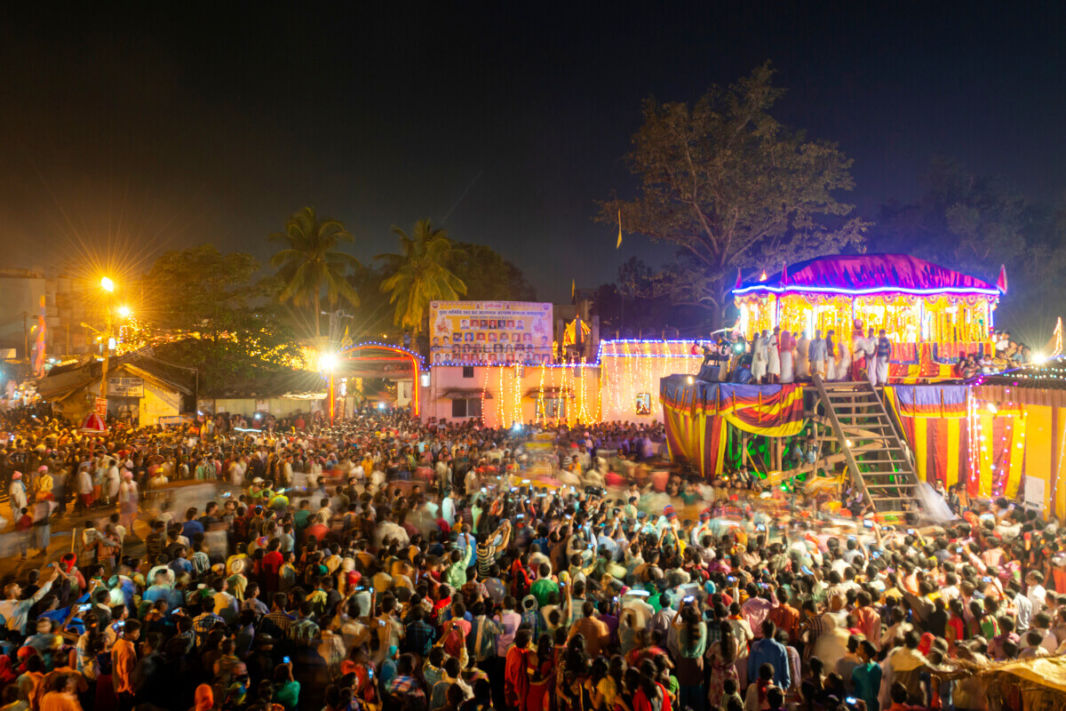

What is the total duration of Bastar Dussehra?
The total Duration of Jagdalpur Dussehra is 75 days-long but the last 10 days – corresponding to Navratri – are the most interesting.
When Jagdalpur Dussehra will start in 2021?
Bastar Dussehra begins with the dark moon in the month of Shravan (end of July) and ends on the thirteenth day of the bright moon in the month of Ashwin (October).
Although there are 12 main events during the whole period, the last ten days, overlapping with Navratri, are the most interesting and festive.
If you want to celebrate Bastar Dussehra in 2021, you will have to be in Jagdalpur Bastar Chhattisgarh before the 7th of October.
The first major event, Kaachan Gadi Puja, should happen on the 7th of October, evening time. It starts around 5pm from the palace and 6pm in the ritual place – a temple dedicated to Kachchin Goddess in Bhangaram Chowk.
I notice that most of my readers only go to Jagdalpur on Dussehra day and it’s really a pity to miss the previous events.
Check with Chhattisgarh Tourism Board a few weeks before to get the full program and confirm the date as it can vary.
In 2019, Kaachan Gadi Puja was on the 28th of September and Baahar Raini was on the 9th of October.
Where Dussehra Bastar is celebrated?
The main festivities take place in Jagdalpur, the administrative headquarter of the Southern district of Bastar in Chhattisgarh.
So, Jagdalpur is the best place to stay during Bastar Dussehra.
I strongly recommend you to stay in Devansh Residency, the best quality for price.
The best place to book your room is Make My Trip. You will find a choice of hotels in Jagdalpur.
>>> Click here to check the offer
The nearby town of Dantewada, in the eponymous district, also hosts some important rituals and can be reached by bus from Jagdalpur.
You can reach Jagdalpur:
- by train via Odisha (Vizag or Bhubaneswar line). Eg a flight to Vishakapatnam then a train from there to Jagdalpur. My favourite option.
- by bus or car from Raipur, the state capital. Eg a flight to Raipur then a bus or private car to Jagdalpur.
Book your flights, train tickets, bus tickets or cab on Make My Trip with the link below. It’s the best option for transportation in India.
>>> Click here to check the timetables and availability
For your flights to India, Asia and the Middle East, I recommend you my favourite company, Qatar Airways.
>> Click here to see the latest prices and availability for your trip
What does Bastar Dussehra celebrate?
Bastar Dussehra is devoted to the local deities, Goddess Danteshwari, the clan Goddess of the Kakatiya rulers of Bastar and her twin sister Goddess Maoli.
The legend says Devi Danteshwari helped the first non-tribal King, Amman Deo from Warangal, in the XIV’s century.
He was conquering new lands and the Goddess promises her protection if he never looked back.
When they arrived in Dantewada, the King didn’t hear the sound of the Goddess’ anklets anymore. He turned back and the Goddess told him she would stop here.
He built the Danteshwari temple for her here and continued his war.
He chose her as the Goddess of his clan.
This temple is also one of the Shakti Peeths.
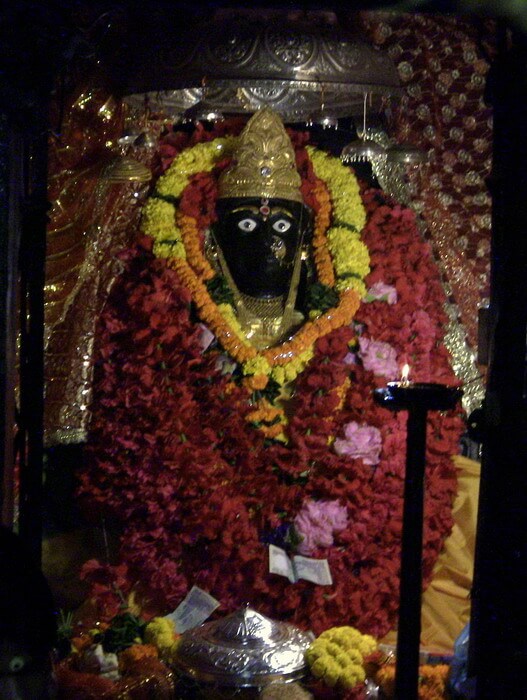
Why Bastar Dussehra is celebrated?
In the XIIth century, the King of Bastar, Purushotam, was so devoted to Lord Jagannath of Puri, that he walked all the way from his capital Bade Dongar to Puri’s temple.
One year later, when he arrived, he offered so many gifts, gold and offerings than the God appeared in the temple priest’s dream. He asked him to give him the title of Rath Pati (head of a chariot) and a chariot from Puri’s rath festival.
As the chariot had 16 wheels, the King decided to return 4 wheels back to Lord Jagannath. This 4 wheels chariot is used during Goncha festival.
The 12 wheels chariot was divided in two, one from 8 wheels, one from 4. They are alternatively used during Bastar Dussehra. In 2017, it will be the 4 wheels chariot, and the Tribes will build 8 wheels one.
It was under King Dalpat Deo in the XVIIth century that Dussehra started being celebrated in the new capital, Jagdalpur.
The King gave a different function to each tribe and community. It didn’t change until now.
It celebrates both Goddess Danteswari and her sister, Maoli, but also the Tribal Gods and Goddesses.
Who celebrates Bastar Dussehra?
The festival involves the different tribes of the district.
The Maharaja of Bastar, HH kamal Chandra Bhanj Deo, leads the ceremony and festivities, as the head of the community and the priest.
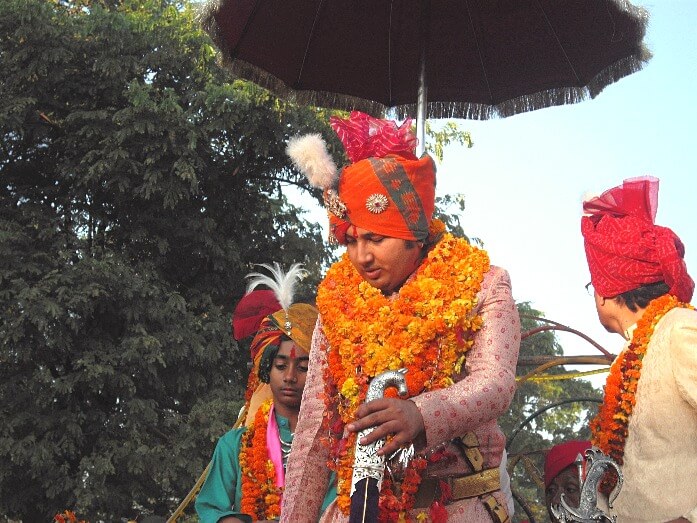
The whole population of the district loves to participate in the rituals that are deeply influenced by the religious beliefs and customs of the Tribes.
You will meet:
- Bison Horn Marias
- Murias
- Abujh (Hill) Marias
- Bhatras
- Dhurwas
- Halbas
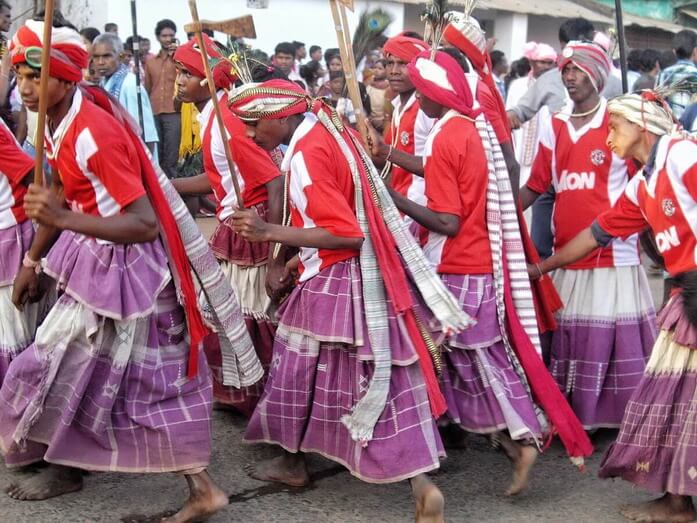
Why is Dussehra in Bastar so different?
Dussehra normally commemorates the victory of Lord Rama and the defeat of Ravana.
Bastar Dussehra has no correlation at all with Rama, Ravana and Ramayana story.
How do people celebrate the Dussehra festival in Bastar?
The festival looks like the life of the Tribal people of the state, deeply connected to their Gods and Goddesses, Nature, their jungle, beliefs and customs.
You will see the leaders (Gaitas) of the villages wearing their red turban, the mediums (Gunias) and witch doctors (Sirahas) in a trance, the men wearing the local Gods in different shapes. The much-revered shape of God is called Anga Deo and can have a ladder like shape (Doli) or even a stick, stone or tree.
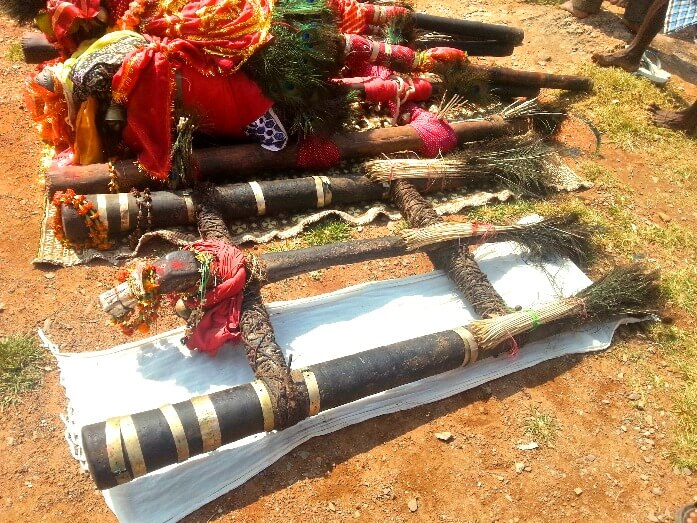
You will witness some Tribal customs that didn’t change, like their devotion to the music, dance, song, magic, the use of their sacred instruments.
You will participate in the same rituals than 400 years ago.
The main rituals of Bastar Dussehra.
There are 12 main events, ranging from the end of July to October. As you will see, the particularity of Bastar Dussehra is that it is a festival where each tribe and each caste has a specific function.
Paat Jatra.
Bastar Dussehra festival is also what is known in India as a Rath Yatra, a festival centred around a giant chariot.
It is therefore natural that the first day of the festival, in July, is centred around the part of the tree that will be used to build the cart. Tribal men bring it from the forests of Bastar to Jagdalpur. Called sargi in local language, it is the sal tree or Shorea robusta, which grows in India, Myanmar and Nepal. This tree is of considerable importance to the tribes of Bastar.
The piece is placed along the walls of the royal palace and will be used to build the instruments to make the annual cart. The making of these wooden tools marks the beginning of the festival.
It begins with a gathering around the wood, which is blessed and becomes sacred. A sacrifice of Mongrian fish (local catfish) and goats is made.
Originally, the Maharaja supervised this ritual, as the person in charge of the Bastar Dussehra rituals. This is no longer always the case, but other pieces of wood can be blessed in his presence in the following months.
Deri Gadhai.
A month later, in August, the tribesmen, dressed in their colourful clothes, brought branches to Sirasar Bhavan (a yellow building next to the royal palace and the place where the tank was built) on their heads. The building encloses a sacred stone around which several Bastar Dussehra rituals take place, which may surprise you given the contrast between animist beliefs and the modernity of the building. This stone would come from the royal palace.
These branches will be used to build a temporary shelter, which was originally built outside. Other objects have been added over time, such as puffed rice. Mongri and goat fish are again sacrificed.
Kachan Gadi.
The Kachan Gadi ritual is in some ways the opening of the last 10 days of Bastar Dussehra. Through this ritual, the goddess Danteswari authorizes the festival to take place. It generally takes place on the first evening of Navratri, in September or October depending on the year.
Tribal musicians first gather on the ground floor of the royal palace. The Maharaja then goes in procession with them. The procession is accompanied by men in trance carrying the palanquin (Anga deo) of their divinity, witch doctors and mediums in trance. They cross the city to an old temple dedicated to the goddess Kachchin in Bhangaram Chowk (Bhangaram district), in the Pathraguda area.
This temple and the goddess Kachchin are of considerable importance to the Bastar as they are linked to the legend of the capital’s installation there. Before Jagdalpur was founded here, the place was inhabited by the Mirgahan community, also called Mahara, who had the goddess Kachchin as their local goddess.
Before officially opening the Bastar Dussehra festivities, the King comes here to ask the goddess to consent to their opening and bless him. It is a very impressive ritual in which a young girl from the Mirgahan-Mahara clan enters a trance to welcome the goddess into her. After a fight against evil, he is laid down on a thorny swing. She feels no pain and is not hurt. She blesses the Maharaja and his relatives by offering them necklaces of flowers.
This ceremony is a reminder that the King who founded Jagdalpur had accepted the goddess Kachchin as his own divinity and revered her enormously.
Jogi Bithai.
This ritual, if not explained, may seem obscure and of little importance to us as Westerners. That would be a mistake…
A young man from the Muria tribe worshipping the goddess Danteshwari begins a 9-day fast, set in a hole in Sirasar Bhavan (where the branch shelter was made) to ask the goddess to bless the region and make sure the festivities go well. He is always chosen from the same family, which no longer remembers the origin of the ritual. The family is known as “Jogi” (hermit).
The young man first visited the Maharaja, before moving to the building where a ceremony with a goat sacrifice took place. He then sits in the hole and blesses all those who visit him during his fast.
Fasting will be closed at Jogi Uthai, a ceremony at which the young man will receive food.
Rath Parikrama.
During the week of Navratri, every evening, last year’s 4-wheeled chariot is driven by the tribes around the royal palace. A small ceremony was held first, then the men of tribes other than the Bison Horn Marias grabbed the rope and pulled the cart all the way along.
On the last two nights, the representation of the goddess Danteshwari got into the chariot and walked around with him.
Nisha Jatra.
In the evening, the King goes to a small temple near Anupama Chowk (Anupama district) with his closest ministers and the royal priest.
They begin with a prayer to the goddess Danteshwari inside the temple, while 12 men from the non-tribal Yadav community (milk producers) arrive from different directions. They carry an earthen pot containing bhog (rice and lentils) on their heads. In a corner of the temple courtyard, 12 goats are waiting for their last hour…
After the puja, the Maharaja sits in the courtyard and the Yadavs present him with the bhog. This would be a way to ensure the prosperity and health of the population and the region, with Yadavs and milk representing prosperity. Once the bhog was offered to the King and the goddess, the Yadavs broke the pot in a corner of the courtyard, in order to symbolically drive out all the calamities that the population and the region could experience (diseases, poverty, evil eye).
The King then offers a part of the bhog to each goat, which is brought to the royal priest. The latter whispers a prayer in their ear and apologizes for taking their lives. Their heads are then cut off, collected with blood and offered to the goddess.
At the end of the bloody offering, the Maharaja returns to the palace by the light of a torch.
Goddess Danteshwari procession from Dantewada.
Danteshwari temple in Dantewada is the most important in the region. Visit it the day a sandalwood statue of the goddess leaves it in palanquin to go to Jagdalpur. It is a beautiful, colourful one-kilometre procession with the Bison Horn Marias dancing in the lead. The palanquin is then placed in a highly decorated truck, which will make several stops in the villages towards Jagdalpur, greeted by local troops of Bison Horn Marias and other local communities.
Maoli Parghav.
In the evening, two processions leave from two different places in Jagdalpur: the first with the Maharaja in his role as royal priest, wearing a wig of flowers and bare feet; the second with the priests of Dantewada wearing the palanquin of the goddess Danteshwari.
They meet on a wooden platform, on which the King takes the palanquin on his shoulders. He carries it inside the temple of his palace, where the statue is installed next to that of her twin sister, in the middle of hundreds of Anga deo (palanquins of divinities) carried by the men of the tribes in trance.
Bheetar Raini and Rath Parikrama.
Each year, the tribes build a new 4 or 8-wheel tank alternately. It is this chariot that will be used to walk the Danteshwari goddess of Dantewada around the palace and will be stolen by the tribes.
The Bison Horn Marias, the only ones allowed to pull the chariot that evening, arrived in small groups from the different parts of Bastar. They dance, play the drum, the Angas Deo (palanquins) push the crowd, the witches and mediums are in a trance.
After a puja (prayer) and the sacrifice of a goat, the statue of the goddess is mounted on the chariot that will be pulled by hundreds of bison horn Marias around the palace.
During the night and as chaos persists, the Marias return to steal the chariot, which they carry to Kumdakot, a field 4 km away, previously in the jungle.
Bahar Raini and Rath Parikrama.
One of my favorite days of Bastar Dussehra and the one everyone is waiting for.
On that day, the Maharaja, in his best attire, went to Kumdakot to pick up the chariot. For the first time in 2019, he went there on horseback and not by jeep. Although he arrives in the afternoon, I like to go there around noon to see the tribal groups arrive with their deities – Anga Deo (palanquins), Kolam Deo (kind of parasol), sticks -, observe the transes and tribal dances.
In a tent, the King begins with a prayer and is then offered the first harvest of the season. He then circumambulates around the chariot, accompanied by the royal family, his ministers and tribes. The return procession begins, with the Marias dancing in the lead, as well as the Dhurwa and their horse-man. Then comes the Maharaja, followed by the Marias pulling the chariot. In 2015, the Marias refused to pull the chariot for several hours: the goat attendant had forgotten to bring the goats for the sacrifice!
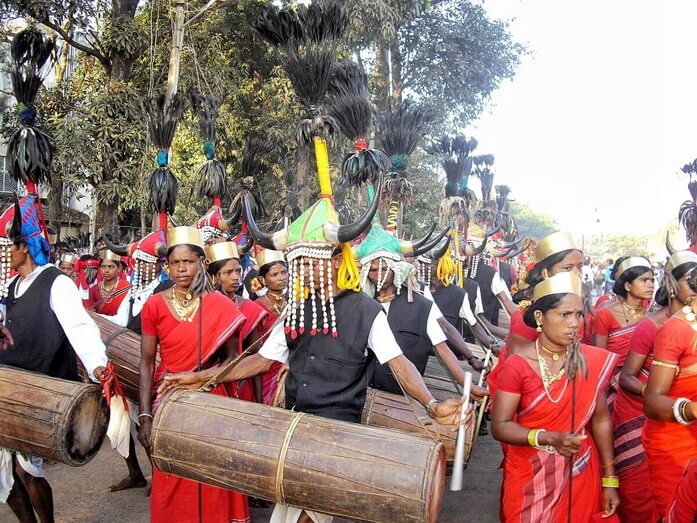
Kachan Jatra.
I discovered this extremely touching and confidential ritual in 2015 and was exceptionally allowed to enter the temple.
In the same place as Kachan Gadi, the little kumari, the living goddess, enters into a trance one last time to the music and songs of the Gurumayas, the women in charge of looking after her. They use a local instrument with a very special music.
She is conducted near the swing of thorns while a goat is sacrificed and offerings are made in gratitude. Before gradually returning to her, she blesses all those who touch her feet. Her relatives gently lead her inside, where she collapses to the ground, her cheeks covered with tears and her eyes lost in the vagueness…
Kutumb Jatra.
All the representations of the deities – Anga Deo, Kolam Deo, sticks – are gathered at the Vidai Mandap of the Mahatma Gandhi School. Animal sacrifices are made in the morning, men enter a trance, mediums and sorcerers are present.
As a sign of the improvement in the security situation for the tribes, in 2015, many tribes that had not come for several decades were present with Anga and Kolam who were sometimes over 100 years old.
In the afternoon, it is the departure for the respective villages.
Shri Danteshwari mata ki bidai or farewell.
This is the final ceremony of Bastar Dussehra, with the procession of the return of the statue of Danteshwari.
How to organize your trip for Bastar Dussehra in 2021?
I now offer a trip planning service. Check the offer here
Conclusion – Bastar Dussehra, the world’s longest festival.
You now have the essential information about Bastar Dussehra, the World’s longest Festival from the tribal state of Chhattisgarh.
Read more articles about Chhattisgarh here.
Did you know this festival?
Have you already experienced it? How was it?

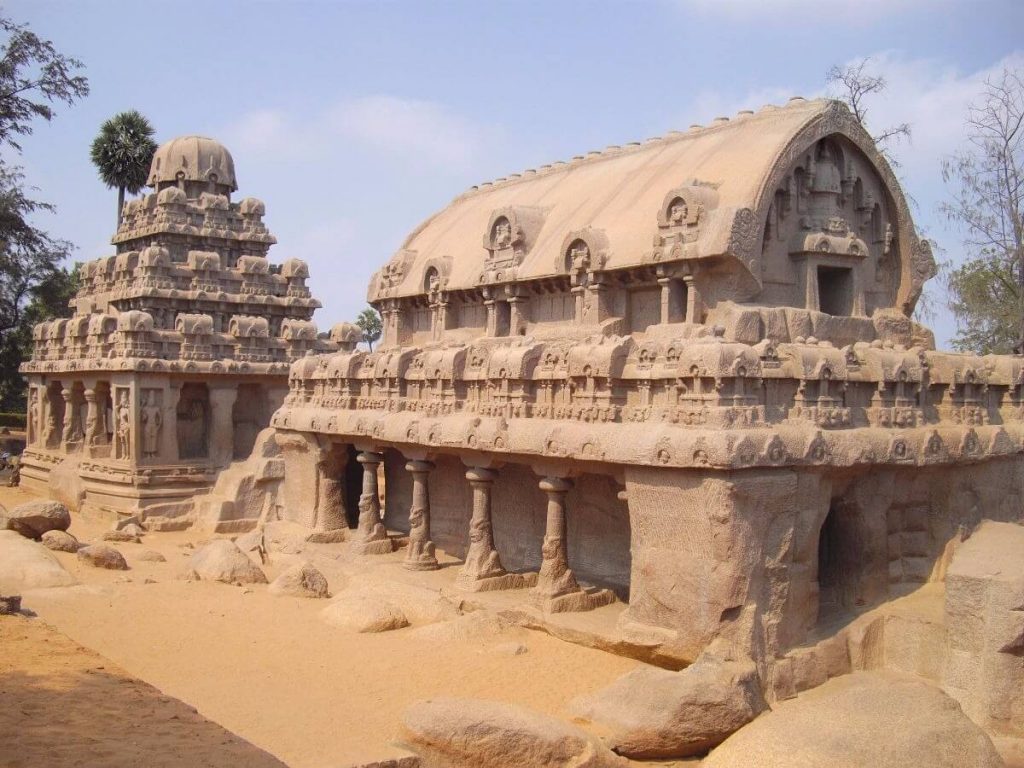
Hello everyone on this forum – thanks.
My name is Mark and i am from luxembourg
best regards 🙂